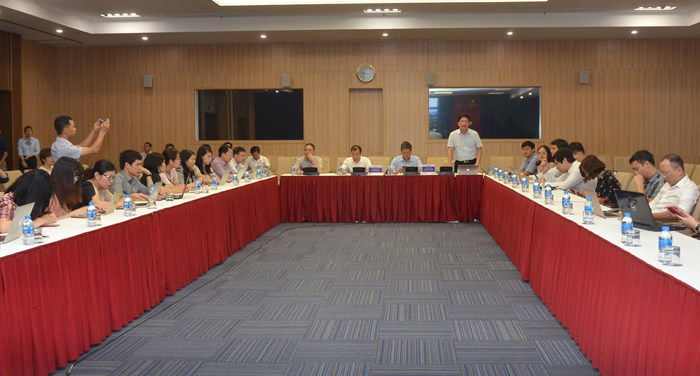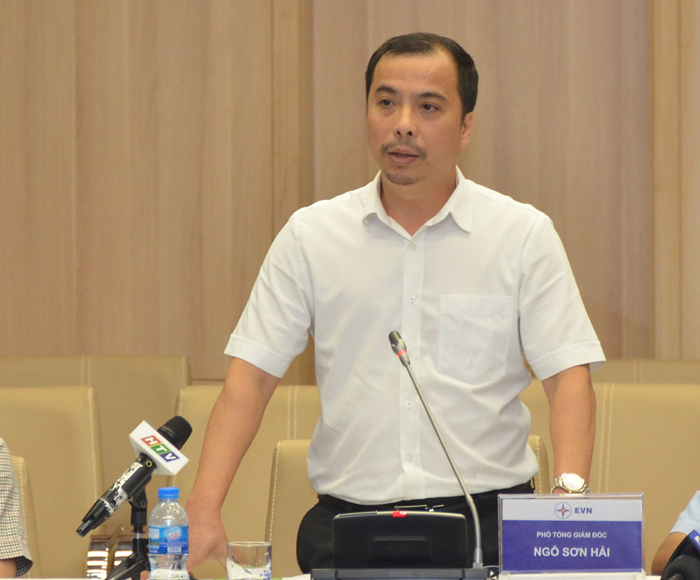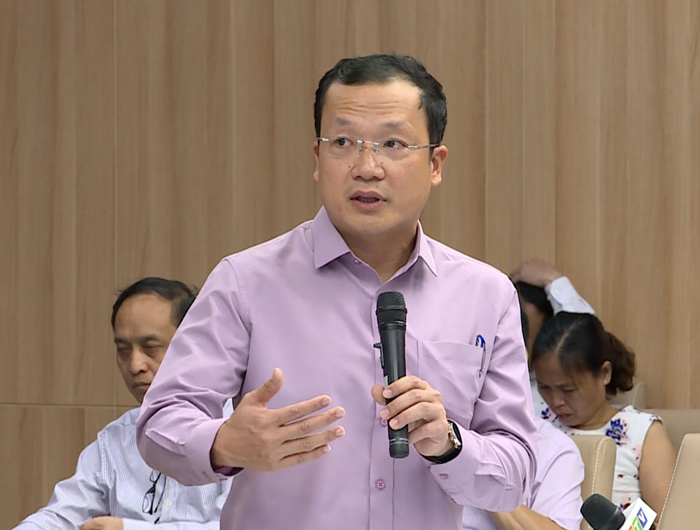Representatives working with journalists and reporters include Vietnam Electricity, are Deputy General Directors Ngo Son Hai, Vo Quang Lam and leaders of EVN’s specialized departments and leaders of the National Load Dispatch Centre.

Journalists and reporters in charge of following up information about the 7th session of the 14th National Assembly attending the meeting
The risk of difficulties in power supply in the coming time
- Reporter of Vietnamnet e-newspapers: Currently, coal-fired thermal power, hydropower, gas turbines still account for a large proportion in Vietnam’s power structure. However, in recent years, no major power sources have been put into operation; Renewable energy has been unstable, while power demand is still very high. Will there be a power shortage in the coming time?
Mr. Ngo Son Hai – EVN’s Deputy General Director: Currently, EVN owns about 60% of the total capacity of the whole system, including joint stock companies and power generation corporations. According to the revised VII Power Planning, by 2020, EVN will reduce its ownership to only 52%; by 2025 it will be 30% and 18% by 2030. Thus, in the coming time, to meet the demand for power not only relies on the role of EVN but also depends on other investors.

EVN’s Deputy General Director Ngo Son Hai answering questions of journalists and reporters
The concern is that some projects of investors outside EVN are behind schedule, so it is very difficult to ensure the supply source for the growth of power demand (from 8-9%).
EVN proactively reported the situation to the Government, Ministries and Agencies for taking solutions to guarantee power capacity in the coming time; Particularly, the Government was proposed to direct investors to ensure the construction progress of power projects.
As for EVN, the Corporation has been making utmost efforts to ensure the progress of assigned projects. Along with that, EVN proposed to Ministries, Agencies and Localities to have solutions, policies and mechanisms to promote propaganda activities on economical and efficient use of power.
Answering the questions related to power price
- Reporter of Vietnamnet e-newspapers: The recent increase in power price will help EVN earn over VND 20,000 billion. How will this amount be used and have it offset the costs of power production?

Mr. Vo Quang Lam – EVN’s Deputy General Director answering questions at the meeting
Mr. Vo Quang Lam – EVN’s Deputy General Director: In 2019, all the input factors of power price are increasing such as coal prices, gas prices, power prices for renewable energy power plants, exchange rate differences, increase in environmental tax, etc., which makes the estimated costs increase more than VND 20,000 billion. All the increased revenue after adjusting the power price is estimated at only over VND 18,000 billion and is entirely used to pay for the increased input costs, and is not even enough to cover power production costs which are expected to increase by over VND 20,000 billion, we will actively implement cost-saving measures to ensure the financial balance.
Reporter of VnMedia e-newspapers: The power consumption and power bills of my family before and after the power price increase are not much different. Specifically, in April 2019, my family used 410kWh, higher than that in March 2019 and the power bill only increased by only VND 80,000. However, I don’t know how power bill is calculated?
Mr. Nguyen Quoc Dung - Head of Sales Department of EVN: Regarding the method of calculating power bill in the month with adjusted power price, in order to facilitate customers to actively look up, an automatic tool was established by EVN on the website of the Group from March 20th, 2019.
Customers can access the link: https://www.evn.com.vn/c3/calc/Cong-cu-tinh-hoa-don-tien-dien-9-172.aspx to calculate their power bill.

Mr. Nguyen Quoc Dung - Head of Sales Department of EVN presenting about business situation - customer services in the past months
Reporter of VnMedia e-newspapers: At present, power staff still has to arrive at every household to take meter readings, so how much does the cost paid to this staff account for in the power price? Why has EVN not yet connected electronic meter readings with computers, personal phones so that people can proactively monitor their family’s power use readings?
Mr. Nguyen Quoc Dung - Head of Sales Department of EVN: Currently, the two types of meters are being used by EVN to meter the consumed power: Mechanical and electronic meters. In which, electronic meters have been put into use since 2005 to gradually replace mechanical ones. Up to now, 10 million electronic meters have been used by EVN out of the total of about 27 million customers.
However, the replacement of mechanical meter readings by electronic ones requires a huge budget. Therefore, in order to avoid waste, the in-use mechanical, but in good condition, are still used by EVN and at the same time EVN develops a roadmap for gradual replacement by electronic meters. EVN’s target by 2020 is that 100% of mechanical meters will be replaced by electronic ones in cities and towns and 50% in rural areas.
The connection of electronic meters to computers has now been deployed for customers with high power consumption, using 3-phase meters. Indicators from the meters will be updated every 30 minutes and made public. Customers not only view meter readings at the present time, but also look up all parameters of power consuming history last year, last month, etc.
For customers using single-phase meters, it is necessary to invest in modern infrastructure systems with a huge capital to make the connection feasible. Therefore, EVN is implementing the connection under the specified roadmap.
Regarding the cost for staff to take the consumption readings, I would like to explain clearly that the taking of the consumption readings is only one among tasks of electrician staff. Therefore, this part of labour cost cannot be separated in the work norms applicable to electric staff.
Over the past years, EVN has paid special attention to the modernization and application of information technology to improve labour productivity. Particularly, the labour productivity of power production and business of the whole Corporation in 2018 reached 2.18 million kWh/person, an increase of 11% compared to that in 2017.
What are the difficulties in operating large amount of solar power and how about the solar power price applicable to consumers if it is calculated correctly and fully?
- Reporter of Inspectorate newspapers: With the incentive policy on the renewable energy of the Prime Minister, currently a series of solar power projects are racing for connection with the grid before June 30th, 2019. Does this affect the operation of the power system?
Mr. Nguyen Duc Ninh - Deputy Director of the National Load Dispatch Centre (A0): Up to now, EVN/A0 has cooperated with investors to inspect and accept the condition of power installation and putting into operation for 44 solar power plants with a total capacity of 2,231MW and 7 wind power plants with a total capacity of 240MW.

Mr. Nguyen Duc Ninh - Deputy Director of the National Load Dispatch Center answering about the operation of the power system
The renewable energy sources in operation have contributed a certain amount of capacity and output to the power system, especially in the central and southern regions. Typically, on May 28th, 2019, renewable power output reached about 8 million kWh/day, accounting for about 6-7% of the daily power output of the whole system (over 720 million kWh).
However, the adverse aspect of solar power is its instability, depending entirely on weather conditions. For traditional power plants, A0 can proactively adjust the capacity of the plant corresponding to the up/down of the power load during the day. But renewable energy sources cannot be calculated because their capacity changes constantly during the day.
Besides, under the revised VII Power Planning, the approved solar power capacity by 2020 is 850MW, but so far over 10,000MW of solar power has been approved.
On April 23rd, 2019, the General Director of EVN had a meeting with nearly 100 investors of solar power plants who signed power purchase contracts with EVN. At that time, only about 150MW of solar power came into operation. Currently, this figure has reached 2,200MW, an increase of approximately 15 times over the past month.
It is expected that by the end of June 2019, the capacity of solar power will continue to increase to 3,500 - 4,000MW and reach 5,000MW by the end of 2019. This means that EVN/A0 has been performing a huge amount of workload.
Another difficulty, since solar power plants are mainly concentrated in Ninh Thuan and Binh Thuan provinces – areas with low load. Specifically, by the end of June 2019, Ninh Thuan and Binh Thuan provinces will have about 2,000MW of solar power in operation, while the load of this region is only about 300MW. Therefore, EVN must transmit 1,700 MW to Ho Chi Minh City and the Southern region.
According to experiences in the world, when developing renewable energy, the transmission problem will be properly taken into account. In fact, in Vietnam, the existing grid system is very difficult to absorb all of the capacity and output of solar power, with the speed of the plants in operation. It can be said to be the largest one in the world today. To build a transmission grid project takes about 3-5 years, while building a solar power plant only takes about 6-8 months.
In operating the system, to solve the uncertainty of renewable energy sources, A0 will have to start up many power units in traditional power plants (but power generation is not allowed) for backup purposes. Currently, in the South, A0’s reserve is about 100-200MW, this figure must increase from 300-600MW in the future, depending on the capacity of solar power put into operation.
It is worth mentioning that, in many times, the power demand has increased in high level, so the power system is no longer available. Therefore, A0 must mobilize oil-burned thermal power units, which are expensive sources, to balance the renewable energy.
- Reporter of Inspectorate newspapers: The purchase price of solar power is set at 9.35cents/kWh and is considered expensive compared to that of hydropower and thermal power. However, this price does not include transmission costs. So, if it is calculated correctly, how much will solar power cost to consumers?
Mr. Nguyen Duc Ninh - Deputy Director of the National Load Dispatch Centre (A0): Because renewable energy is a very new field, there is currently no exact figure for solar power price from the plant to the consumer. It is estimated that, if it is calculated correctly and fully, the price of solar power will be 13-14cents/kWh, equivalent to about VND 3,000/kWh; however, if it is a roof-top solar power, this cost will be saved because it does not require any investment in grid system.